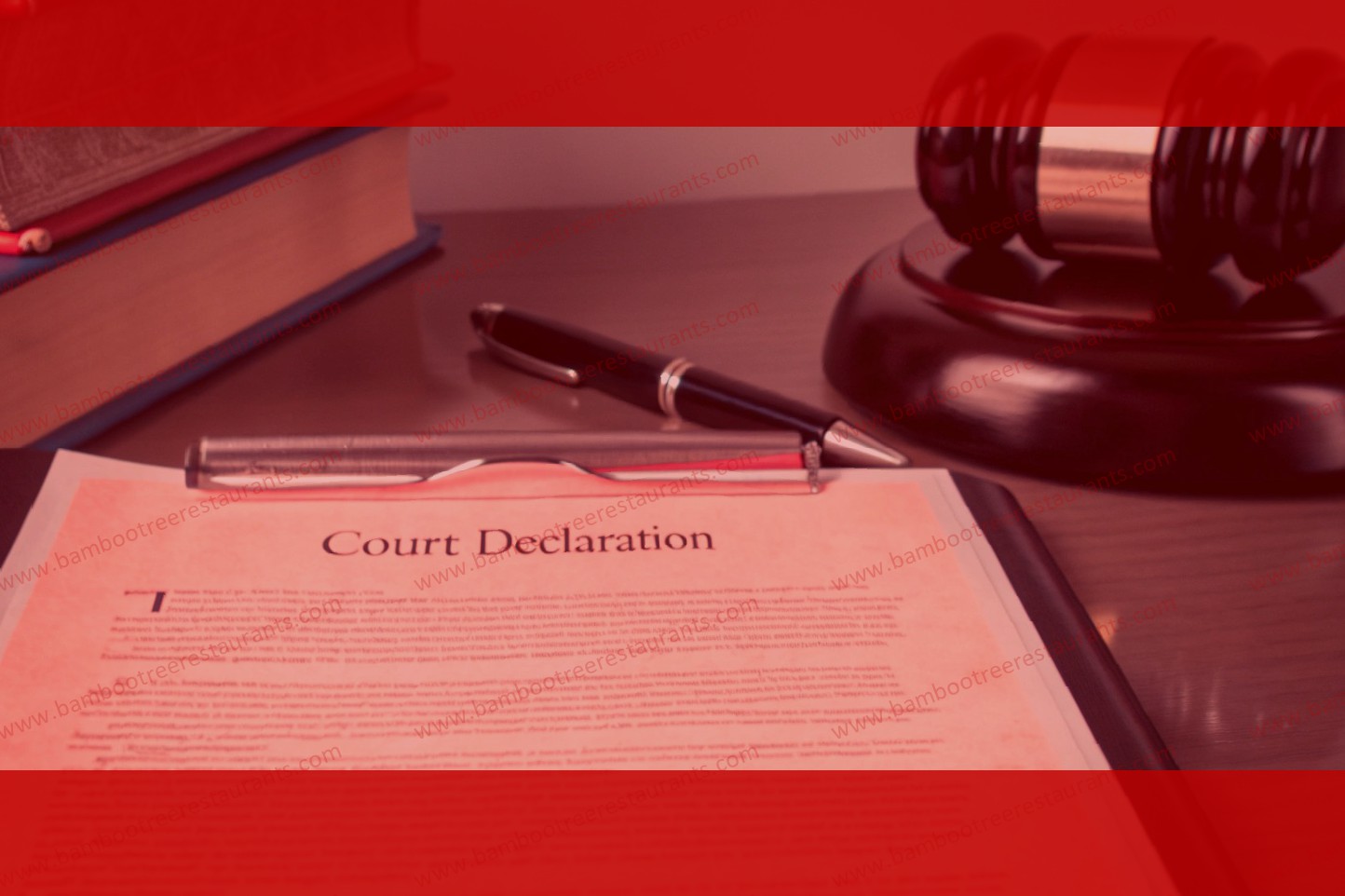What is a Court Declaration?
A court declaration is an explanation of what you know to be true regarding your particular case. People often refer to a declaration as a "sworn declaration"; however, it’s not sworn. It only becomes "sworn" if it is filed with the court or presented to the other party. Once served upon the other party or filed with the court, it is deemed a sworn declaration because it has been verified as true under penalty of perjury. A typical declaration includes an introductory sentence explaining what the declaration is supporting and the person’s name, address, and relationship to the lawsuit or criminal matter. A declaration consists of numbered paragraphs, setting forth factual statements regarding the case, or explaining why the declaration is being submitted to the judge. Each statement in the declaration needs to be based on the facts, not opinions. All declarations have a final paragraph with a sentence that says what the declaration is alleging or attempting to do, and how the court could potentially rule upon the request. In the legal world, declarations can be used for a variety of reasons . A declaration can be used to support a motion for a temporary restraining order. Declarations are allowed and even encouraged during the discovery process of a court case, so you have ample opportunity to present all necessary evidence in your favor. In criminal matters, a declaration is used to support a motion (i.e. a request) for a new trial, to reduce a sentence, or even to get the judge to hear your testimony. A declaration’s usual role in criminal cases is to present evidence that may in fact lessen the charges against you or help prove your innocence. It is rare that a declaration is presented to a judge, solely for the sake of the declaration. Usually, attached to a declaration, or mentioned in its body, will be a motion for the judge to take action based on the claims made in the declaration. For example, if you ask for permission to move out of state with the children, you would present the judge with a declaration, along with a motion asking for the permission to move. The preparation of a declaration will take skill, and it is crucial to have an experienced lawyer properly draft a well written declaration on your behalf.
The Elements of a Court Declaration
The foundational aspect of writing a persuasive declaration is to not only pay attention to the content of the declaration, but also to pay attention to the form of the declaration. In other words, the declaration must contain all of the essential elements required of a declaration. In California, to be persuasive, a court declaration should include the following basic elements:
- A descriptive title identifying the contents of the declaration – i.e., "Declaration of [insert declarant’s name]" or simply "Declaration."
- A descriptive introduction identifying the declarant by name and description of the declarant, formerly known as the declarant’s relationship to the issues at hand. This introductory paragraph informs the reader for whom the declarant has an affiliation with the matters being discussed in the declaration. For example, "I, [insert declarant’s name], am an attorney licensed to practice law in the State of California, and I am the Partner in _______ LLP."
- A detailed facts section identifying each fact contained in the declaration, and cited to the source of information for that fact. This section is the meat and potatoes of the declaration, and details every substantive fact upon which the declarant is willing to testify, to directly controvert the expressed must-have’s of the declaration.
- A closing summary paragraph stating that the declarant’s testimony is true to the best of the declarant’s knowledge and belief. This is a standard summary statement to remind the Court that the declarant is under oath to tell the truth.
- The declarant’s signature. A declaration is only effective and persuasive if the declarant signs his or her name to the declaration.
- The declarant’s typed name. Similar to what is required by a signature, the typed name of the declarant is critical to the effectiveness of the declaration, especially where the declarant signs his or her signature along with a partner or associate. It’s possible that the declarant will no longer be at the firm, or work with the attorney, and without a printed name on the declaration, there would be no way to identify who made the declaration without gathering extrinsic evidence outside of the declaration itself.
- A signature line.
How to Draft a Winning Declaration
As a starting point, the declaration must be in a certain format for the court’s requirements. The heading title should contain: In the body of the declaration, it is important to include an introductory paragraph that states the general purpose of the declaration. For example: The body of the declaration must state the facts of the case under the penalty of perjury. The declaration must be stated in numbered paragraphs for the purpose of clarity. Each paragraph should be factual. The declaration should be sequential and state the facts in the order that they occurred, if possible. For example, if the declaration concerns a business relationship, then consider stating the facts in chronological order, starting with formation of the business relationship. Use common adjectives and favorable words. A declaration should never be an emotional statement. The declaration should also be simple and ordinary so that a person unfamiliar with the subject matter should be able to understand all of the points for which the declaration is being drafted. In addition, if you are going to cite evidence to support the factual statements in the declaration, be sure to append the relevant evidence at the end of the declaration with appropriate tabs or attachments. That way the judge will have all the evidence and facts she needs to review the declaration. Finally, the last paragraph of the declaration should state the declaration is being made under penalty of perjury and the date and location the declaration is being signed.
Tactical Tips for Constraining a Declaration
A declaration can help you make your point with a court. To do that, your declaration needs to stand on its own. Remember that the court may not know anything about your case. So, the declaration must provide a complete and thorough description of the situation. You will not be able to assume that the court has any information about your case.
Your declaration needs to give the right impression. A declaration is a formal document. It has a legal context. So, keep it professional. Be factual. Be serious. Avoid excessive informal language, jokes, or sarcasm. For example, stop using the exclamation point!!! Just don’t. You can, of course, use an exclamation point for an awesome point that deserves one. But don’t force it. Also, avoid the phrase "slam dunk." That is as clichéd as the exclamation point!!! And I would suggest avoiding the story of how even though the light was red , the officer gave you a ticket anyway, and then your buddy said "hey dude, you should fight that" and you said "yeah, man, I should." Pretty much a waste of time.
In life, most of us are pretty informal, even in writing. But you want your declaration to come off as professional. Keep it concise. Be thorough. Give all the details you want to give. But keep it on point. Avoid conjecture. Also, avoid emotional language. It won’t help you. If you are overly concerned about something, explain your concern. But don’t complain. Explain. Do not repeat yourself. You can use adjectives. But don’t overdo them. You don’t need flowery adjectives. They hurt the flow and get in the way. They also can come across as patronizing when you try too hard.
Pitfalls in Declarations
Common mistakes that people make in connection with declarations include the following:
One of the first issues to consider is whether the declaration is even needed whatsoever. A written court declaration is not always necessary. Sometimes a form declaration is simply a waste of time, effort and money. For instance, when it comes to a motion for attorneys’ fees, it is nearly always a waste of time to prepare and file a declaration where the declaration merely states the obvious about the attorney fees requested in the motion, setting forth the hours spent, rates requested, and the total fees sought. The Court will simply request the billing records for the attorney fees in question so that the trial court judge or judicial officer can review them themselves to determine whether the amount of time spent and the hourly rates sought are reasonable. In almost all such cases, there is also a waste of time and money to prepare a written court declaration in connection with a purely procedural issue, which the trial court judge or judicial officer can usually decide based on his or her familiarity with the case, applicable law, and court rules. Finally, some declarations are redundant. For instance, sometimes parties prepare declarations that only restate what the trial court judge or judicial officer already knows.
Multiple declarations on the same subject matter are generally unnecessary. If the declaration is not even needed, then you obviously do not need more than one declaration on the same subject matter. Finally, unnecessary summary declarations are frequently a waste of valuable time and legal fees. A brief summary declaration typically only makes sense on a motion for attorneys’ fees, where the declaration contains only a general summary of the information regarding the party or parties seeking attorneys’ fees, including a general summary of the grounds for attorneys’ fees, such as requesting fees based on a base contract provision, statute, in equity, or all three if three bases for attorneys’ fees are all potentially viable.
Too often declarations are riddled with too many conclusions and insufficient evidentiary facts. Even written court declarations which really cannot be avoided because it is impossible for a party to convey information without them fall victim to far too many conclusions, such as "I was in shock when Bob hit me", etc. This type of conclusory information is not admissible, as a layperson cannot offer opinions or conclusions in written court declarations unless the conclusions are rationally based based on the witness’s perception and either (1) helpful to the trier of fact, such as a declaration from a fact witness indicating that they observed a party unplugging a refrigerator to avoid getting "frozen out" of the marital residence while it was up for sale; or (2) the conclusions are based on the specialized knowledge of the layperson, such as a non-expert electrician offering conclusions based on his expert knowledge as an electrician on the wiring system of a residence.
Conclusive assertions in written court declarations are likewise quite common, and nearly as unhelpful to the judge or judicial officer as a written court declaration riddled with conclusions. What is called for in a court declaration is not a statement that, for example, "In my opinion, Bob emotionally abused my child by allowing him to play with that gun." Rather, the declaration should be written in a manner that conveys facts with more useful specificity, such as, "After I caught Billy playing with the gun, I found two bullets lying next to him on the table, and Billy told me Bob gave him that gun for Christmas, and then hid it in the dresser drawer to avoid your mom finding it."
The following provides a list of other common mistakes that people make in drafting declarations:
Finally, declarations are sometimes riddled with incomplete information. It is always prudent to make sure that the declaration meets all requirements. For example, in a declaration in support of a motion to continue a trial, make sure to inform the Court that the motion was properly served on the other side, and that the other side will stipulate to it being continued pursuant to the California Family Code on that basis.
Editing and Proofing Your Declaration
Your declaration must be accurate and it must also be clear so that people reading it will know what you are saying. A judge reviewing a tangled mess of a declaration will quickly become frustrated. So after you have drafted your declaration, read it and read it again. Have others read it as well, to look for errors, typos or confusion. If there are any concerns you have as to whether everything is correct/MUST be right, you should confer with an attorney to make sure that your declaration will be as convincing as possible . It may be tempting to think that the language of the law is the language of the people (consider the recent political campaigns), but unfortunately, it is not always the case. Your declaration must accurately reflect each claim with the proper legal terminology, and sometimes those arguments are difficult to express without legal assistance.




+ There are no comments
Add yours